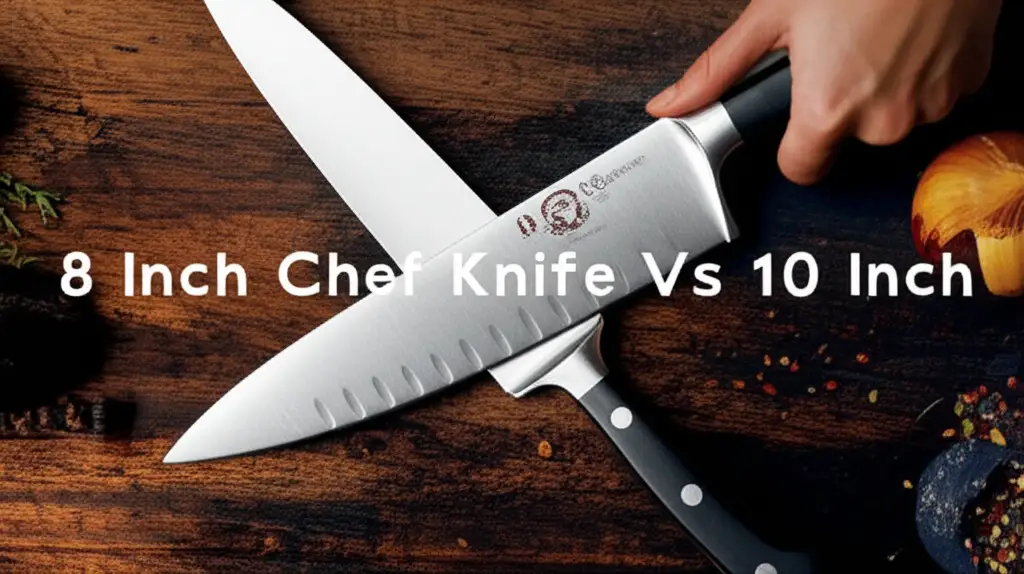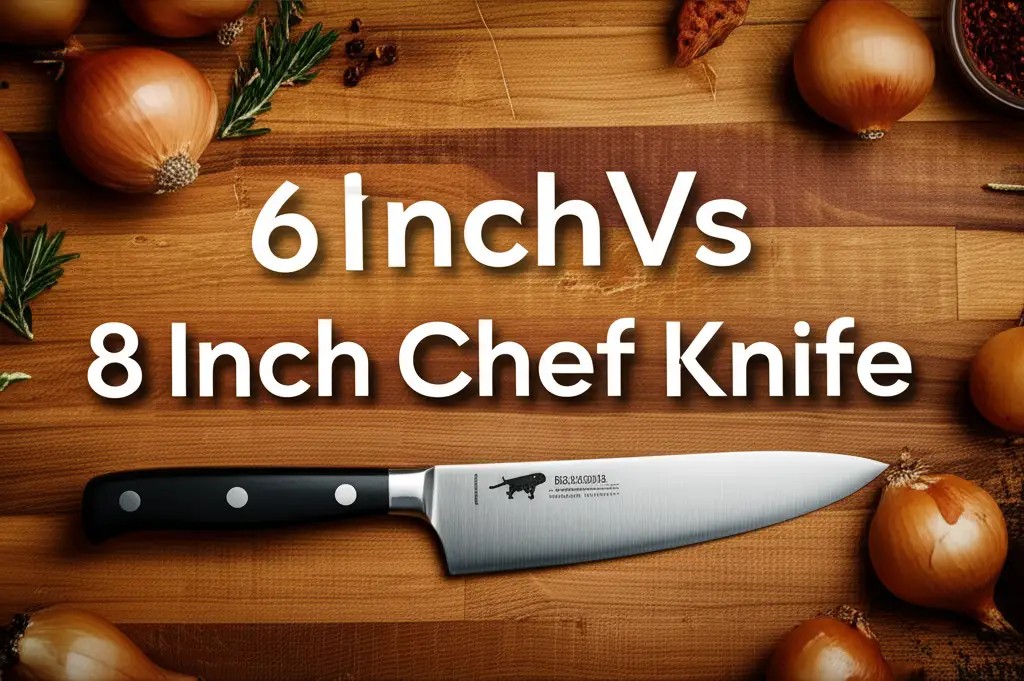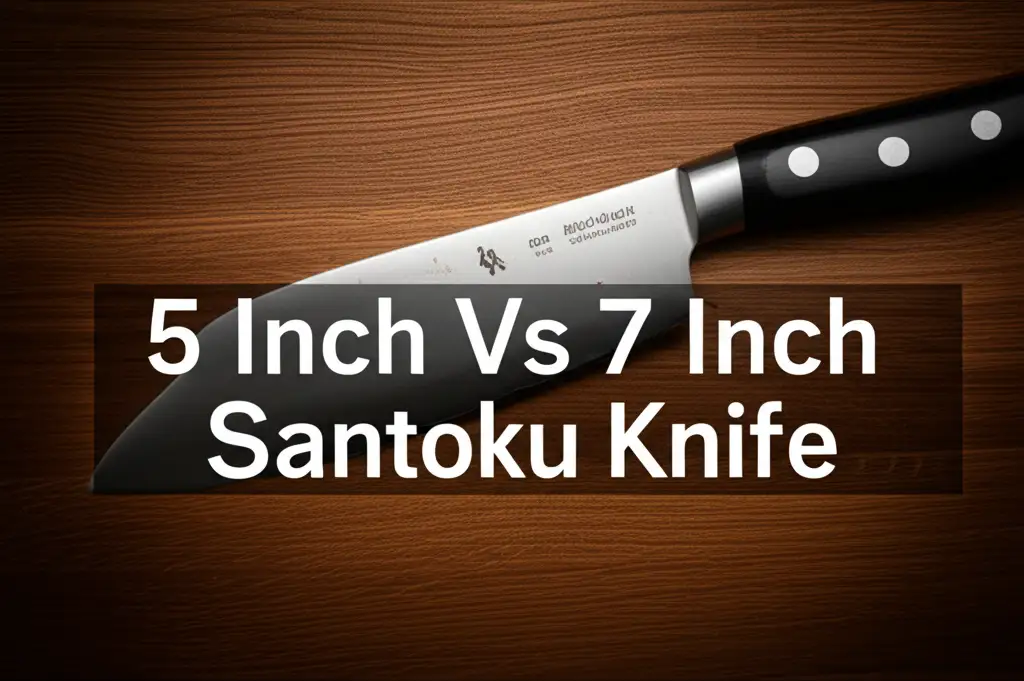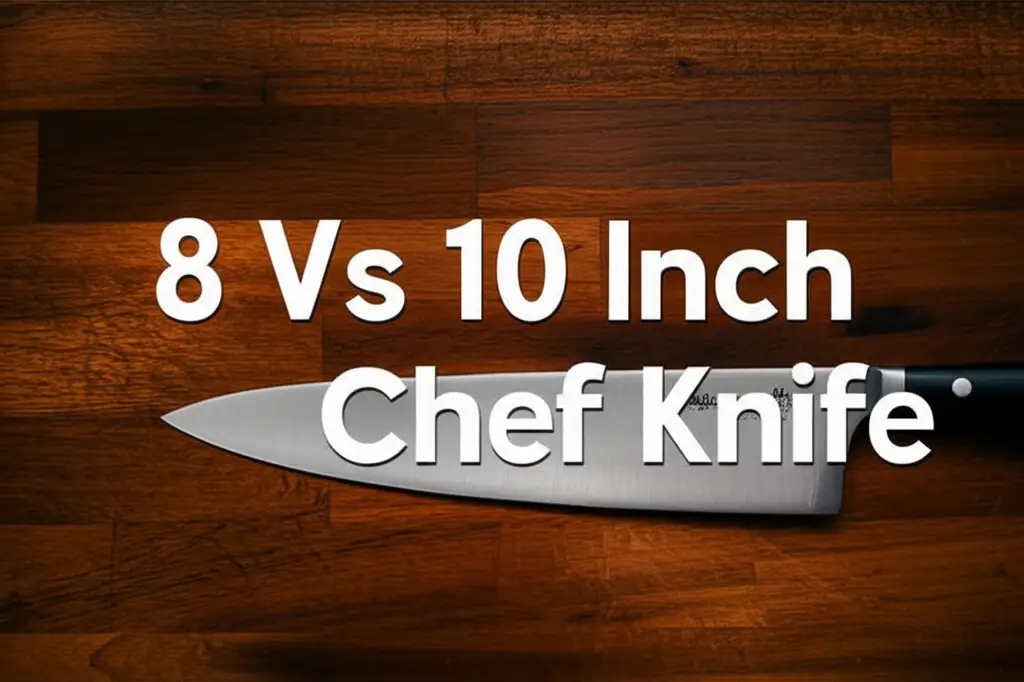· Elira Thomsen · Kitchen Tools · 12 min read
8 Inch Chef Knife Vs 10 Inch

Choosing Your Blade: 8 Inch Chef Knife Vs 10 Inch
Picking the right chef knife for your kitchen can feel like a big decision. You stand in front of the knife display, seeing all the different sizes. A common choice many home cooks and professional chefs face is between an 8 inch chef knife vs 10 inch. Both knives are workhorses in the kitchen, but they serve different needs.
I remember my first time buying a quality chef knife. The options overwhelmed me. Understanding the differences between an 8-inch and a 10-inch blade helps you make an informed choice. This guide will walk you through the specifics of each knife size. We will explore their uses, benefits, and the factors you should consider before buying. By the end, you will know which chef knife is best for your cooking style and comfort.
Takeaway
- 8-inch chef knives offer more control and maneuverability. They suit smaller hands, tight spaces, and precise tasks.
- 10-inch chef knives provide power and efficiency for large ingredients. They work well for bulk prepping and experienced users.
- Consider your hand size, cutting style, and typical tasks when choosing.
- Blade material and handle design are important for comfort and performance.
- Proper care extends the life of any chef knife.
A chef knife’s best size depends on your personal comfort, the types of food you prepare, and your cutting technique. An 8-inch knife offers excellent control for daily tasks and smaller produce. A 10-inch knife provides power for large cuts and efficiency in bulk prep. Choose the one that feels balanced and safe in your hand.
Understanding Chef Knife Basics
A chef knife is a fundamental tool in any kitchen. It performs many tasks, from chopping vegetables to slicing meat. The blade shape allows for a rocking motion, which is efficient for cutting. Knife size refers to the length of the blade, from its tip to the bolster (the part where the blade meets the handle).
Most chef knives range from 6 inches to 12 inches in length. The 8-inch and 10-inch sizes are the most popular for general use. My own kitchen often sees both sizes in action, depending on the meal. The weight and balance of a knife change with its length. Longer blades usually mean more weight. This weight can assist with certain cutting tasks. It also requires more strength and control from the user.
The Nimble 8-Inch Chef Knife: Control and Precision
The 8 inch chef knife is a favorite among many home cooks. Its size offers a good balance of reach and control. This knife feels comfortable for people with smaller hands. It also works well in smaller kitchen spaces. I often reach for my 8-inch knife for everyday cooking.
This blade length is excellent for detailed work. You can finely mince garlic or slice delicate herbs easily. The shorter blade makes it simple to maneuver around ingredients. It provides good precision. When I am working with small vegetables, like shallots or mushrooms, the 8-inch knife is my top choice. It allows for quick, controlled movements. For example, when you clean mushrooms, a precise cut can save time and reduce waste. You can learn more about how to clean mushrooms for cooking here.
Key benefits of an 8-inch chef knife:
- Better control: The shorter blade is easier to manage. This reduces the risk of accidental cuts.
- Increased maneuverability: You can work quickly and accurately on a cutting board.
- Ideal for smaller tasks: Perfect for mincing, dicing small vegetables, or slicing individual portions.
- Comfort for many users: People with smaller hands or those new to cooking often prefer this size. It feels less intimidating.
- Less fatigue: Lighter weight means less strain during long prep sessions.
This size is a great starting point for anyone building their knife collection. It handles most general cooking tasks with ease.
The Mighty 10-Inch Chef Knife: Power and Efficiency
The 10 inch chef knife is a larger, more powerful tool. Professional chefs often prefer this size for its efficiency. It covers more surface area with each cut. This saves time during bulk food preparation. When I prepare a large meal for guests, the 10-inch knife becomes essential.
This knife excels at breaking down large items. Think about slicing through a watermelon or a roasted turkey. Its length allows for longer, smoother cuts. This creates uniform slices with fewer strokes. The added weight of the 10-inch blade also helps. It uses gravity to assist with cutting through tough foods. This can include dense root vegetables or large cuts of meat.
Key benefits of a 10-inch chef knife:
- Efficiency in bulk prep: It cuts more food with each stroke. This speeds up large cooking projects.
- Power for large ingredients: Handles big vegetables, large roasts, and whole poultry with ease.
- Longer, cleaner slices: The extended blade creates smooth cuts in one pass. This is good for slicing roasts or fish fillets.
- Professional choice: Many experienced cooks use this size for its superior cutting power.
- Momentum: The extra weight can help push through difficult items.
Using a 10-inch knife requires some practice. You need good control and arm strength to wield it safely. If you regularly cook for a crowd or process large amounts of food, this knife is a strong contender.
Ergonomics and Hand Comfort: Finding Your Fit
The comfort of your chef knife is very important. It impacts your safety and efficiency in the kitchen. When comparing an 8 inch chef knife vs 10 inch, consider how each feels in your hand. Hand size plays a big role in this. My hands are medium-sized, so I find both comfortable. But smaller hands might struggle with a 10-inch knife.
A knife that is too large or too small for your grip can cause fatigue. It can also lead to improper technique. This increases the risk of accidents. Hold the knife before buying it. Check if your fingers wrap comfortably around the handle. Make sure your knuckles clear the cutting board when you chop. This is called knuckle clearance. Good knuckle clearance prevents your knuckles from hitting the board.
Factors affecting comfort:
- Hand size: Smaller hands generally prefer an 8-inch knife. Larger hands might find a 10-inch knife more comfortable.
- Grip style: Different grips (pinch grip, handle grip) feel better with certain sizes.
- Weight distribution: The balance point of the knife should feel natural. A well-balanced knife feels lighter than it is.
- Handle material: Handles made from wood, composite, or synthetic materials offer different textures and grips.
- Fatigue: A knife that is too heavy or unbalanced can cause wrist and arm strain over time. This is especially true during long cooking sessions.
Remember, the goal is to find a knife that feels like an extension of your hand. This allows for smooth, powerful cuts without discomfort.
Kitchen Space and Storage Considerations
The size of your kitchen and available storage also factor into your knife choice. A bigger knife needs more space. This might seem obvious, but it is an important practical point. If your kitchen is small, a 10-inch chef knife could feel unwieldy.
Consider your cutting board size. A 10-inch blade might hang off a smaller board. This can be unsafe. You want enough room to move the knife freely. A standard cutting board usually handles an 8-inch knife well. For a 10-inch knife, you might need a larger board.
Storage options for knives:
- Magnetic knife strips: These save drawer space. Ensure your wall space accommodates a longer strip for a 10-inch knife.
- Knife blocks: Check the slots. Some blocks have specific slots for longer blades.
- In-drawer trays: These keep knives safe and organized. Again, check the length of your drawer.
- Sheaths: If you store knives in a drawer, sheaths protect the blades and your fingers.
My kitchen has limited counter space. I prefer a magnetic strip to keep my knives accessible. This also helps when I need to maintain other kitchen items. Just like you need to keep your refrigerator clean for a healthy kitchen environment, proper knife storage contributes to overall kitchen hygiene. You can find tips on how to keep your refrigerator clean here. Make sure your chosen knife size fits your current kitchen setup.
Knife Care and Maintenance for Longevity
Proper care keeps any chef knife sharp and safe. This applies to both the 8 inch chef knife vs 10 inch. A well-maintained knife performs better and lasts longer. Neglecting your knife will make it dull and harder to use. A dull knife is also more dangerous. It requires more force, which can lead to slips.
Essential knife care steps:
- Hand wash immediately: Always wash your knife by hand with warm, soapy water after each use. Dishwashers can damage the blade and handle materials.
- Dry thoroughly: Water causes rust. Dry your knife completely with a clean towel right after washing.
- Store safely: Use a knife block, magnetic strip, or blade guard. This protects the edge and prevents accidents. Proper storage also helps prevent damage to other kitchen tools. For instance, when maintaining other tools like a ruler or a blender, similar cleaning principles apply to ensure their longevity. You might be interested in tips for keeping other tools clean, like how to make a specific ruler model easier to clean here.
- Sharpen regularly: Use a sharpening stone or a knife sharpener to maintain a keen edge. Regular honing with a steel realigns the edge between sharpenings.
- Use appropriate cutting surfaces: Always cut on wood or plastic boards. Glass, stone, or metal surfaces dull the blade quickly.
Taking good care of your knife ensures it remains a reliable tool for years. My sharp knives make cooking a joy. It also makes prep work faster and safer.
Making Your Choice: Factors to Consider
Deciding between an 8 inch chef knife vs 10 inch involves weighing several personal and practical factors. There is no single “best” choice for everyone. The ideal knife for you is the one that feels most comfortable and efficient in your hands.
Consider these questions when choosing:
- What is your hand size? If you have smaller hands, an 8-inch knife might offer better control.
- What do you cook most often?
- For daily meals with smaller ingredients, an 8-inch knife excels.
- For large family meals, bulk food prep, or breaking down large meats, a 10-inch knife provides a big advantage.
- What is your skill level?
- Beginners often find an 8-inch knife easier to manage and less intimidating.
- Experienced cooks might appreciate the power and efficiency of a 10-inch knife.
- How much kitchen space do you have? A larger knife needs more counter and storage space.
- What is your preferred cutting style? Some people prefer rapid, controlled chopping (8-inch). Others like long, smooth slicing motions (10-inch).
- Do you own other specialized knives? If you have a separate carving knife, a 10-inch chef knife might be less necessary. If you are comparing other kitchen appliances, such as a Breville juicer vs Ninja blender, you are already thinking about specialized tools. Understanding the specific function helps your choice. You can read more about various kitchen appliances like the Breville juicer vs Ninja blender here.
It is also fine to own both! Many professional and home kitchens have both sizes. This allows you to choose the perfect tool for each specific task. I have both, and I use them equally often for different jobs.
Frequently Asked Questions
What is the most common size for a chef knife? The 8-inch chef knife is the most common and versatile size for home cooks. It offers a good balance of maneuverability and cutting power for most daily kitchen tasks. Many professionals also use an 8-inch blade for specific precision work. This size generally suits a wide range of hand sizes and skill levels.
Is a 10-inch chef knife too big for home use? A 10-inch chef knife is not too big if you have larger hands or regularly prepare large quantities of food. It excels at tasks like slicing roasts or chopping large vegetables. However, it requires more control and practice. For casual home cooks with limited space, an 8-inch knife might be more practical.
Does knife length affect cutting technique? Yes, knife length affects cutting technique. A shorter 8-inch knife supports more agile, precise, and rapid chopping. A longer 10-inch knife encourages longer, smoother slicing motions. Its added weight can assist with powerful cuts. The best technique always depends on the food item and the desired result.
How do I know which chef knife size is right for me? The best way to know is to hold both sizes. See how they feel in your hand. Check for comfortable grip and knuckle clearance on a cutting board. Consider the type of food you cut most often. If you handle many large items, a 10-inch might be better. For general tasks, an 8-inch is usually a safe choice.
Can a beginner use a 10-inch chef knife? A beginner can use a 10-inch chef knife, but it may have a steeper learning curve. The extra length and weight demand more control and precise technique. Starting with an 8-inch knife might build confidence and proper habits more quickly. Once comfortable, beginners can then transition to a 10-inch blade if needed for specific tasks.
Conclusion
Choosing between an 8 inch chef knife vs 10 inch is a key step in setting up your kitchen. Both sizes are excellent tools, but they shine in different scenarios. The 8-inch knife offers agility, control, and comfort for everyday tasks and smaller ingredients. It is often the preferred choice for many home cooks. The 10-inch knife brings power and efficiency, perfect for large-scale prep and breaking down bigger foods.
I hope this guide helps you make your decision. Think about your hand size, the types of food you prepare, and your comfort level. The right chef knife will feel like an extension of your arm. It will make your cooking experience more enjoyable and efficient. So, take your time, consider your options, and choose the chef knife that will be your trusted partner in the kitchen for years to come. Practice safe cutting techniques with your new knife and enjoy cooking!





